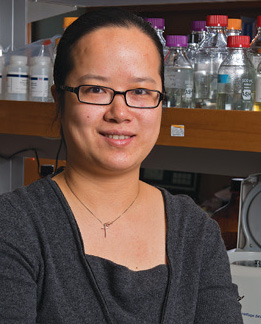
It’s well known that humans inherit 23 pairs of chromosomes, one allosome (sex chromosome) and 22 autosomes from each parent. Likewise, there are two versions, or alleles, of autosomal genes, one from the mother and one from the father. Usually, both alleles are expressed.
Sometimes, however, only one inherited copy of a gene is expressed – for unknown reasons. Northwestern Medicine scientists investigated the details of this mysterious phenomenon known as genomic imprinting in a recent study published in Genes & Development.
“During the formation of the egg or the sperm, certain genes are marked to ensure that they are silenced in the offspring,” explained co-author Edwin Smith, PhD, research associate professor of Biochemistry and Molecular Genetics. “Which genes are imprinted? We are still learning the answer to this question but we do know that many of them have important roles in development and that the expression of these genes is carefully controlled.”
Scientists know that some genes are imprinted as eggs form, so only the father’s copies of those genes will be expressed in the developing embryo. At the same time, other genes are imprinted as sperm form, so only the mother’s copies will be expressed.
“Although the reason for such complex gene regulation is unknown, the consequences of genomic imprinting have major implications for human disease,” Smith said. “For the majority of genes that are expressed equally from both maternal and paternal alleles, most mutations in one copy can be compensated by the remaining good copy of the gene. However, what happens for imprinted genes, where there is only one copy that can be expressed?”
Working with senior author Ali Shilatifard, PhD, chair and Robert Francis Furchgott Professor of Biochemistry and Molecular Genetics, Smith and first author Zhuojuan Luo, PhD, a former postdoctoral fellow in Shilatifard’s lab, discovered how a protein called AFF3 binds regions of DNA within imprinted genes.
AFF3 is a component of a family of transcription factors called the super elongation complex (SEC). Shilatifard’s lab previously showed that other proteins in the SEC family, AFF1 and AFF4, are involved in chromosomal translocations with the MLL gene, a major player in leukemia.
In an effort to learn more about AFF3, the scientists in the new study used mouse embryonic stem cells to determine where the protein lives in the genome. They found it in three very different types of sites on the chromosome.
“First, AFF3 is found at active genes with RNA polymerase, as any good transcription elongation factor should be found,” Luo said. “It is also found at sites known as enhancers, which tell nearby genes when they should be expressed. The third and most unexpected place we found AFF3 is at imprinted loci, where it was associating with the gene silencing machinery on the silent allele.”
The scientists believe the protein could have an important role regulating imprinted gene expression.
“We think that the transcription elongation factor AFF3 is recruited to both the inactive and active alleles to help fine-tune expression of these very dose-sensitive imprinted genes,” Luo said. “Intriguingly, naturally occurring genetic variations in both AFF3 have been linked to type 1 diabetes and rheumatoid arthritis, which some scientists suspect is also associated with imprinted gene expression.”
The study was supported by National Institutes of Health grant R01GM069905.






